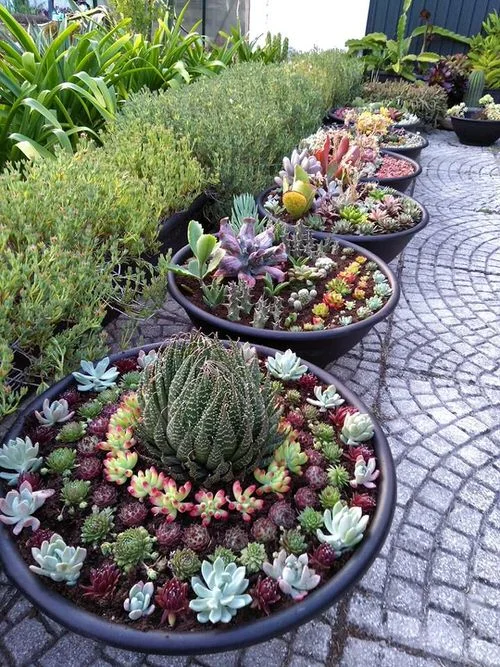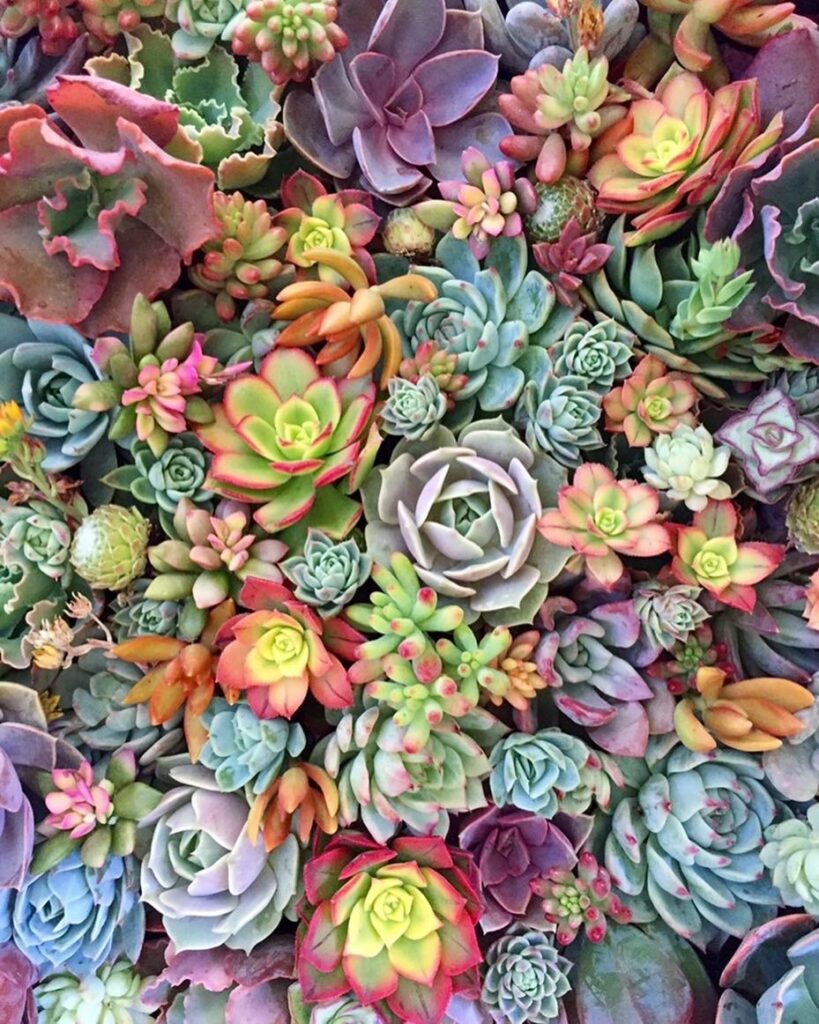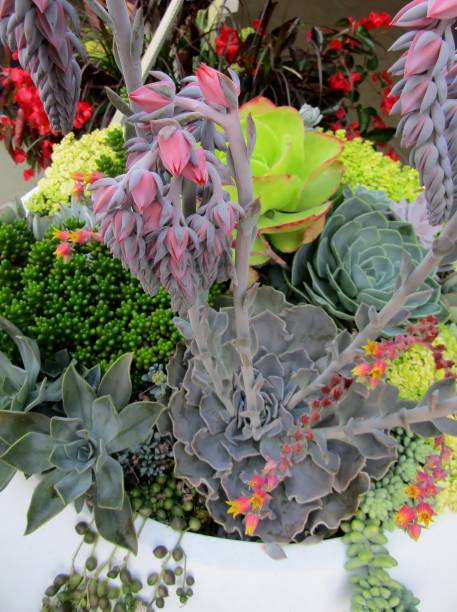Introduction :-
Succulent Plant, with their striking shapes and vibrant colors, have taken the gardening world by storm in recent years. These hardy plants not only offer an aesthetic appeal but also come with an aura of mystery and resilience. In this blog post, we will dive into the fascinating world of succulents, exploring their secrets and unveiling the elegance that lies within these remarkable plants.

1 : The Resilient World of Succulents :-
Succulents, often regarded as nature’s survivors, thrive in some of the harshest and most unforgiving environments on the planet. To truly appreciate the elegance of these remarkable plants, one must first understand the secrets behind their resilience.
1.1 Adapting to Harsh Conditions :- Succulents have evolved over millions of years to adapt to arid and semiarid regions where water is scarce. Their unique feature is their ability to store water in various parts of their structure, such as their leaves, stems, and roots. This water storage capacity enables them to endure extended periods of drought that would cause most other plants to wither and die.
1.2 Water Storage Mechanisms :- The primary water storage feature of succulents is their fleshy leaves. These leaves are often thick, waxy, or hairy, which helps reduce water loss through transpiration. Some succulents, like the iconic Aloe vera, even have a gel-like substance inside their leaves that acts as a water reservoir. This adaptation allows succulents to absorb and store water when it’s available and use it efficiently during dry spells.
1.3 Surviving in Extreme Temperatures :- Succulents are also masters of temperature regulation. In scorching deserts, they often grow close to the ground to escape the intense heat and sunlight. Additionally, their unique anatomy minimizes surface area exposed to the sun, reducing water loss through evaporation. Some succulents, like the Saguaro cactus, can also expand and contract their stem tissues to regulate their internal temperature.

1.4 Root Systems and Soil Adaptations :- The root systems of succulents are designed to maximize water absorption. Shallow but wide-reaching roots quickly capture any rainwater or dew that falls. These roots are also excellent at securing the plant in rocky or sandy soils, preventing erosion during heavy rains or strong winds.
1.5 Succulent Biodiversity :- Succulents plant are incredibly diverse, with over 10,000 species worldwide, each adapted to its unique environment. In the deserts of North America, you’ll find iconic species like the Joshua Tree, while the African continent boasts a wide array of succulent plants, including the striking Hoodia gordonii. Exploring this biodiversity reveals the depth of the adaptations succulents have developed to thrive in their respective ecosystems.
2: The Artistry of Form and Color :-
Succulents are not just resilient survivors; they are also natural artists, exhibiting a stunning array of forms and colors that captivate the hearts of plant enthusiasts, artists, and photographers alike. In this chapter, we will delve into the remarkable diversity and aesthetic appeal of succulent plants.
2.1 A Kaleidoscope of Shapes :- Succulents plant come in an astonishing variety of shapes. From the rosette form of Echeveria to the tall, slender columns of San Pedro cacti, each succulent species has its unique geometry. Some, like the Crassula perforata (String of Buttons), resemble perfectly stacked coins, while others, such as Lithops (Living Stones), mimic pebbles or stones in shape. This kaleidoscope of forms invites endless creativity in garden design and plant arrangements.
2.2 The Color Palette of Succulents :- One of the most enchanting aspects of succulents is their vibrant and diverse color palette. Succulent leaves can range from shades of green so deep they appear almost black, to soft pastels, bright reds, purples, and even silvery blues. Variations in color often intensify when the plant experiences stress, such as extreme sunlight or drought, creating a dynamic display of ever-changing hues.
2.3 Patterns and Textures :- Succulents are not limited to monochromatic beauty; many feature intricate patterns and textures. Some have leaves adorned with stripes, spots, or intricate lattices. The fuzzy, velvety texture of Kalanchoe tomentosa (Panda Plant) contrasts with the smooth, glossy surface of Crassula ovata (Jade Plant). The diversity of textures and patterns among succulents adds depth and dimension to their visual appeal.

2.4 Architectural Elegance :- Certain succulents, like the architectural Agave americana, create a sense of grandeur in gardens and landscapes. Their impressive size, dramatic symmetry, and the symphony of colors they exhibit as they mature make them focal points in any setting. The sculptural quality of these succulents lends an air of sophistication and elegance to garden designs.
2.5 Seasonal Surprises :- Succulent plant aren’t static in their appearance; they change with the seasons and environmental conditions. During the growing season, some may produce colorful flowers in a wide range of shapes, sizes, and colors, adding yet another layer of visual interest to their already captivating form. The transformation of succulents throughout the year offers a sense of anticipation and delight to those who cultivate them.
2.6 Art and Photography Inspiration :- Succulent plant have long been a muse for artists and photographers. Their mesmerizing forms and colors provide endless inspiration for creative expression. Whether you’re an artist looking to capture the intricate details of a succulent’s leaves or a photographer aiming to frame the striking contrast between a succulent and its arid surroundings, these plants offer a wellspring of artistic possibilities.
3: Succulent Secrets: How to Care for Them :-
Unlocking the elegance of succulents not only involves appreciating their beauty but also mastering the art of caring for these unique plants. In this chapter, we will delve into the essential secrets of succulent care, from the right soil mix to watering techniques and more.
3.1 Soil Selection and Preparation :- The secret to successful succulent care begins with the soil. Succulents require well-draining soil that mimics their native habitats. A mix of potting soil and perlite or sand works well for potted succulents. In-ground succulents benefit from soil amendments like gravel or crushed granite to enhance drainage. Understanding and preparing the right soil mix is the foundation for healthy succulent growth.
3.2 The Art of Watering :- One of the most crucial secrets to succulent plant care is understanding their unique watering needs. Contrary to the belief that succulents thrive on neglect, they do need regular watering but in moderation. Water the plant thoroughly, allowing excess water to drain away, and then wait until the soil is almost completely dry before watering again. Overwatering is a common mistake that can lead to root rot, so mastering the art of watering is essential.
3.3 Sunlight Requirements :- Succulents plants are sun lovers, but their sunlight requirements can vary depending on the species. Most succulents prefer bright, indirect light, while some can tolerate full sun. Understanding the specific needs of your succulents and providing them with the right amount of sunlight is crucial for healthy growth and vibrant colors.

3.4 Potting and Container Selection :- Choosing the right pot or container for your succulents is another secret to their successful care. Select containers with drainage holes to prevent water from pooling at the bottom, which can lead to root rot. The size of the pot should match the size of the plant, allowing room for growth but not excessively large. Proper potting and container selection ensure that your succulents have a healthy and happy home.
3.5 Propagation Techniques :- Succulents are some of the easiest plants to propagate, and learning the secrets of propagation can be immensely satisfying. You can create new plants from leaves, stem cuttings, or offsets (small shoots that grow at the base of the mother plant). Each propagation method has its own secrets and best practices, allowing you to expand your succulent collection or share your plants with others.
3.6 Dealing with Pests and Diseases :- Even hardy succulents can fall victim to pests and diseases if not cared for properly. Knowing how to identify common succulent pests like mealybugs and aphids, and diseases like powdery mildew, is vital. Additionally, understanding how to treat these issues using organic or chemical methods will help keep your succulents healthy.
3.7 Seasonal Care and Dormancy :- Succulents, like many plants, go through growth and dormancy periods. Understanding these seasonal changes can help you adjust your care routine accordingly. Some succulents may require less water or lower light during dormancy, while others remain active year-round. Being attuned to these seasonal shifts is a secret to long-term succulent success.
3.8 Patience and Observation :- Perhaps the most valuable secret of succulent care is patience and keen observation. Each succulent has its unique personality, and it may take time to understand its specific needs. Regularly observing your plants, noting changes in appearance or behavior, and adjusting your care routine accordingly is the key to becoming a skilled succulent enthusiast. By mastering the secrets of succulent care, you not only ensure the health and longevity of these elegant plants but also create the ideal conditions for them to reveal their full beauty and potential in your garden or indoor space. Succulents are more than just low-maintenance; they are an art form that thrives with the right care and attention.
4: Succulent Elegance in Your Space :-
Succulent plant, with their unique beauty and adaptability, have the remarkable ability to infuse elegance into any living space. In this chapter, we will explore creative ways to incorporate succulents into your home decor, making them an integral part of your living environment.
4.1 Indoor Oasis: The Power of Indoor Succulents :- Succulents can transform the ambiance of your indoor spaces, turning them into lush, green oases. Their compact size makes them ideal for decorating small apartments or homes with limited space. Whether placed on windowsills, shelves, or tables, succulents add a touch of nature’s elegance to any room.

4.2 Container Gardening: Creating Miniature Worlds :- Container gardening is a delightful way to showcase the elegance of succulents. You can use a variety of containers, from traditional pots to unconventional items like teacups, wooden crates, or glass terrariums. Creating mini succulent gardens in these containers allows you to design unique and eye-catching displays that reflect your personal style.
4.3 Vertical Gardens: Going Upward with Elegance :- Vertical gardens are a fantastic way to maximize space and add succulent elegance to your home. Using wall-mounted planters or specially designed living wall systems, you can create captivating vertical gardens indoors. This vertical approach not only saves space but also makes a stunning design statement.
4.4 Succulent Centerpieces: Dining in Style :- For special occasions or everyday elegance, consider using succulent plant centerpieces for your dining table. Succulents’ variety in form and color can be combined creatively to craft visually striking arrangements. These living centerpieces not only look impressive but also serve as conversation starters.
4.5 Terrariums: Capturing Microcosms of Beauty :- Terrariums are captivating microcosms that allow you to showcase succulents in a glass enclosure. These self-contained ecosystems require minimal care and can be customized to fit any design aesthetic, from desert landscapes to lush tropical scenes. They bring an enchanting touch of nature to your living space.
4.6 Hanging Gardens: Elegance from Above :- Hanging succulent plant gardens add a touch of whimsy and elegance to your home. You can use macramé plant hangers, decorative hooks, or wall-mounted planters to suspend succulents from ceilings or walls. This unique perspective allows you to appreciate their beauty from different angles.

4.7 Succulent Art: Living Masterpieces :- Succulents can be used as living art pieces in your home. Create living wall art by planting succulents in a frame or shadow box. These living masterpieces become ever-evolving works of art as the succulents grow and change over time.
4.8 Succulent Themes: Tailoring to Your Style :- Succulents can adapt to various design styles, from modern and minimalistic to rustic and bohemian. By selecting the right pots, planters, and accessories, you can tailor your succulent decor to match your interior design preferences, creating a harmonious and elegant atmosphere.
4.9 Maintenance Tips: Sustaining Elegance :- Maintaining the elegance of your indoor succulent arrangements involves periodic care. This includes adjusting watering schedules according to the season, ensuring they receive adequate light, and periodically repotting to accommodate growth. With proper maintenance, your succulents will continue to enhance your living space with their grace and charm. By incorporating succulents into your indoor decor using these creative ideas, you can infuse your living space with the timeless elegance of these remarkable plants. Whether you have a green thumb or are new to gardening, succulents offer an accessible and rewarding way to bring the beauty of nature into your home.
5: Beyond Beauty: Practical Uses of Succulents :-
While succulents are renowned for their aesthetic appeal, they have a lot more to offer than just their stunning looks. In this chapter, we will explore the practical uses of succulents, including their historical and modern applications in medicine, food, and more.
5.1 Traditional Medicine: Aloe Vera and More :- Succulents have a rich history of use in traditional medicine. Aloe vera, one of the most well-known succulents, has been used for centuries to treat various skin conditions, including burns, sunburn, and wounds. Other succulents, like Haworthia and Gasteria, have also been used for their medicinal properties. Understanding the healing potential of these plants can be invaluable for natural remedies.
5.2 Edible Succulents: Nutrition from Nature :- Some succulents are not just ornamental; they are edible too. Agave plants, for example, are used to make agave nectar, a natural sweetener. Nopales, the pads of the prickly pear cactus, are a staple in Mexican cuisine. Exploring the culinary potential of edible succulents adds a unique and nutritious dimension to your diet.

5.3 Soil Stabilization and Erosion Control :- The strong and extensive root systems of succulents make them excellent candidates for soil stabilization and erosion control in landscapes. Planting succulents on slopes or in areas prone to erosion can help prevent soil loss and maintain the integrity of the landscape.
5.4 Air Purification: Natural Filters :- Succulents, like other plants, have the ability to purify the air by absorbing pollutants and releasing oxygen. While not as effective as some other houseplants for air purification, they still contribute to creating a healthier indoor environment by reducing indoor air pollution.
5.5 Landscape Design: Drought-Tolerant Beauty :- In regions with water scarcity, succulents play a vital role in landscape design. Their low water requirements make them ideal choices for creating water-wise gardens. Succulents can be used to design stunning landscapes that are not only aesthetically pleasing but also environmentally responsible.
5.6 Botanical Research and Conservation :- Succulents are of significant interest to botanists and conservationists. Studying these plants provides insights into adaptations to arid environments and offers potential solutions for crop cultivation in challenging conditions. Conservation efforts also focus on preserving endangered succulent species threatened by habitat destruction and illegal collection.
5.7 Craft and Artistry: Succulent Crafts :- Succulents can be incorporated into a wide range of craft projects, from wreaths and arrangements to jewelry and even candles. Their unique forms and colors add a touch of natural elegance to handmade creations, making them popular choices for DIY enthusiasts and artists.

5.8 Biodiversity Conservation :- Succulents are vital components of arid ecosystems around the world. Protecting these plants is not only essential for preserving their beauty and utility but also for conserving the biodiversity of these fragile environments. Understanding the practical roles succulents play in their ecosystems underscores their significance in broader ecological contexts. By exploring the practical uses of succulents, we gain a deeper appreciation for these remarkable plants. Beyond their role as ornamental treasures, succulents have made substantial contributions to human health, nutrition, environmental conservation, and creativity throughout history and continue to do so today. Understanding and utilizing the practical aspects of succulents adds a layer of functionality to their inherent elegance.
Conclusion: Embracing the Enigmatic Elegance of Succulents
In the world of plants, succulents hold a unique place. Their elegance lies not only in their captivating appearance but also in their resilience and adaptability. As you embark on your journey to unveil the mysteries of succulents, you’ll find that these hardy plants have much to teach us about beauty, survival, and the art of thriving in challenging conditions. Whether you’re a seasoned gardener or just starting your green adventure, succulents offer a world of wonder waiting to be explored.
So, go ahead, unlock the secrets, and embrace the enigmatic elegance of succulents in your life.
